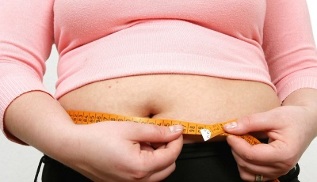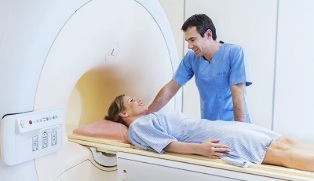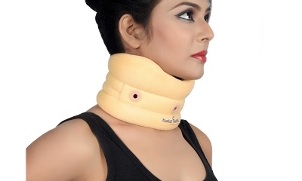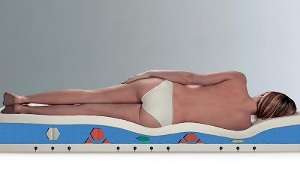Cervical osteochondrosis is a common disease in women. The fairer sex over the age of 30 are the most sensitive to it. 75% of women face this unpleasant disease, and the consequences and severity of the disease can be quite different.
Symptoms of Cervical Osteochondrosis in Women

It is already possible to diagnose the symptoms of female osteochondrosis at an early stage, as the cervical spine discs are close together and have a small height. Osteochondrosis of the cervix can lead to serious consequences - complications and even death. Indeed, the arteries pass around the neck, which nourishes the brain, nerve trunks, and roots that connect to the lungs, arms, and heart, as well as the spinal cord. Therefore, you should not delay treatment with a good doctor.
In order for a woman to be able to diagnose cervical osteochondrosis, she should pay attention to the following signs:
- There is a stretching of the neck and unpleasant painful sensations when turning;
- Frequent recurrent occipital and temporary headaches;
- shooting pains radiating to the neck;
- Rapid fatigue, weakness and tiredness;
- high temperature;
- Strong neck, difficult to bend;
- With a small load on the arm or when coughing, unpleasant pain occurs in the shoulder;
- numbness and tingling in the limbs and tongue;
- dizziness, darkening of the eyes;
- snoring in sleep;
- difficulty swallowing;
- Unreasonable anxiety, fear;
- changes independent of the mood cycle;
- sleep disorders;
- sharp deterioration of memory and attention;
- jump in blood pressure (either increase or decrease);
- Pain in the heart, hearing loss and ringing in the ears, complications of vision are much rarer.
- nausea, vomiting;
- The skin takes on a bluish tinge.
Cervical osteochondrosis can lead to fever and poor health.
Features of female osteochondrosisImportant!Particularly acute cervical osteochondrosis is experienced by women during menopause.
Osteochondrosis is a disorder of the musculoskeletal system that can cause the intervertebral discs and joints to collapse. Due to the structural characteristics of the body, the symptoms of cervical osteochondrosis are more pronounced in women than in men. The fact is that the side of the man's shoulder is wider, it supports the entire spine, helps to reload the neck.
The cervical region of a woman is characterized by high activity and a large number of nerve fibers that work as conductors between the brain and other organs. Deformation of the intervertebral discs causes rapid pressure on the roots of the nerve ending fibers. Roughly speaking, women have more fragile spines and thinner bone tissue.
Important!Pregnancy, followed by child care, also exacerbates the problem. During pregnancy, the load on the spine increases and breastfeeding in an uncomfortable position and constantly carrying the baby in your arms leads to aggravation of the disease.
There are several stages in the development of cervical osteochondrosis:
- Decreased position of the spine due to dehydration of the nucleus pulposus (the interior of the intervertebral disc, which should normally be filled with semi-liquid and gelatinous tissues).
- Muscles and yokes collapse, causing an imbalance, or movement of the spine.
- Dislocation of the intervertebral discs (outside their contents) and arthrosis.
- The human body tries to help the spine return the "loose" vertebrae to their place, removing the supporting and protective barriers. To do this, osteophytes appear on the vertebrae - bone growths. Fibrous tissue also grows. As a result, the motor segment of the spine is in a kind of shell that impedes activity.
Causes of the disease in women

It is believed that cases of cervical osteochondrosis in women are associated with salt deposits, but this is not the case. Osteochondrosis is a major cause of salt deposits. Scientists claim that there are many reasons for the emergence of cervical osteochondrosis. Let us consider the basic:
- Climax. The fact is that the intake of progesterone in the body is decreasing more and more and the muscles in the cervical region are also shrinking. All this leads to a weakening of the spinal section;
- Weakening of the immune system, frequent diseases;
- Excess weight;
- circulatory disorders;
- vertebral artery abnormalities arising from birth trauma, infections, and heredity;
- Seated work, especially at the computer;
- flat feet;
- incorrect posture;
- smoking and excessive alcohol consumption;
- Excessive exercise;
- Heavy load on the spine during pregnancy;
- Improper and unbalanced diet;
- Poor metabolism, metabolic problems;
- Any injury to the neck;
- rheumatism or injury;
- hormonal disorders in the body;
- hypothermia;
- Inheritance.
Excess weight puts extra stress on the joints and joints, as well as causing problems with the cardiovascular system.
Why is cervical osteochondrosis dangerous?
Lack of treatment can lead to a woman becoming disabled. If you do not start treatment for osteochondrosis in time, then there is a risk of complications - from the most minor to the most acute:
- Constant pain in the head, dizziness.
- Regular sudden loss of consciousness.
- Hearing and sight problems.
- Blood circulation is reduced in the brain. Frequent increase in blood pressure
- .
- Problems can begin in the central nervous system: speech, coordination, and behavioral disorders.
- Sciatica and other diseases of the spine.
- vessels are caught in the brain section.
- Spine movement.
- walking disorder due to spinal stenosis.
- Interstitial hernias and rashes.
- Schmorl hernia.
An increase in blood pressure during osteochondrosis may be related to poor blood flow in the arteries on the way to the brain. Stretched arteries occur due to osteochondrosis.
Examination and treatment
Cervical osteochondrosis has many common symptoms with other diseases, so before starting treatment the neuropathologist listens carefully to the patient and collects a medical history.
Diagnostic tests are then performed:

- Radiography.Using a cervical spine x-ray, the doctor will determine the location of the disease. In the picture he will see the change in the shape of the spinal segment, the presence of osteophytes and the narrowing of the intervertebral discs.
- Computed tomography or magnetic resonance imaging. These are the most effective ways today to find out which defects exist and where they are located in the spinal column.
- Myelography.Contrast fluid is injected into the spinal canal for examination. The procedure is not safe: the patient may develop allergies and there is a risk of spinal cord injury if the puncture is unsuccessful. However, in cervical osteochondrosis, such an examination is rarely performed unless you need to examine the entire spine.
MRI can help you to make an accurate diagnosis and determine the degree of pathology development.
In order to cure cervical osteochondrosis, the doctor prescribes a complex treatment. The goals of therapy are to relieve muscle spasms, relieve pain, and reduce intradiscal pressure. Different types of therapy are used at different stages of disease development.
Treatment usually goes through stages:
- Medications.Cartilage tissue repair using chondroprotectors. Vasodilators are used to supply blood to the brain. All of the above eliminates inflammation, pain syndrome and improves metabolic processes in the intervertebral discs. Analgesics and anti-inflammatory drugs in the form of gels or tablets are used as first aid. They can prescribe nootropics and drugs with magnesium. Osteochondrosis can be treated with sedatives as long-term illness can lead to stress and depression. Sometimes it is enough to drink a tincture of mother or valerian.
- Physiotherapy.Aims to eliminate disorders in the affected areas of the spine, alleviate pain syndromes, improve blood circulation. A good massage by a competent specialist, electrophoresis with anesthetic solutions, as well as laser therapy will help you in the early stages of the disease. The procedures relieve muscle tension and stimulate blood circulation. In severe cases, magnetotherapy, dynamics, ultrasound, electroanalgesia, and ultraviolet light are used. Physiotherapy gives effect after the 3rd procedure, the general condition improves, insomnia, headache and tinnitus disappear.
- Manual therapy.The treatment has good efficacy and appreciative reviews. The chiropractor will return the spine to its place for a few sessions, ensuring their mobility and correct posture.
- Acupuncture.It is also called reflexology. The goal is to influence the dystrophic transformations in muscle tissues, remove inflammation and pain, and normalize blood circulation. Women with low pain have a greater chance of recovery, their lymphatic flow is accelerated and blood flow is normalized.
- Orthopedic treatment.The specialist prescribes special sleeping pads to free the spinal column. Underwater traction of the spine is also recommended to relax the muscles from the effects of warm water. Traction involves the use of various devices to enlarge the interstitial space.
- Proper and clean food.By providing the body with healthy fats, carbohydrates and proteins, as well as minerals and vitamins, a woman can significantly speed up the healing process.
- Physical activity.Your doctor may prescribe both physiotherapy exercises and special exercises for the cervical spine. Physical education aims to restore mobility of the cervical area and blood supply. It corrects posture and strengthens the muscle corset. In addition, regular exercise, such as in the gym, will prevent the progression of cervical osteochondrosis.
- Wearing a corset.There is a special device for the cervical spine called the collar. It is tough and stable. Wearing a collar eliminates pain syndromes, improves posture and speeds up recovery.

When choosing a collar you need to choose the right height of the product. To do this, you need to measure the distance from the lamb to the corner of the lower jaw.
Home treatment
In order for the disease not to be detected or diagnosed at an early stage, a woman should monitor her health, diet and lifestyle.
To ease the condition, you can use folk recipes at home:
- Grate potatoes Grate on a fine grater, add a small amount of honey and mix. The resulting mixture should be applied to the cervical spine, where it hurts the most. Repeat the treatment once a week.
- Rinse the chicken leaves and apply to the affected area. Follow the compress with a bandage and sleep with it overnight. Usually in the morning you can feel relief and improvement. For more effect, the procedure should be repeated for 3 or more days.
should be done in cervical gymnastics to strengthen the neck muscles and restore spinal mobility. Exercises are possible for prevention, but you should exercise smoothly and without sudden movements to avoid muscle spasm:
- tilted forward.Sit down, place one palm on your forehead and tilt your head forward while resisting with your palm. One tilt - 10 seconds. After a short rest, repeat the exercise again. Deviation from the
- page.sat, one palm placed on top of the temple area. Bend your head to the side, while pressing it with your palm, resist. Continue for 10 seconds. Repeat the exercise after resting.
- turns the page.Sit or stand on a chair, lower your arms along your torso. Smoothly turn your head to the extreme right position, then to the extreme left. Repeat 10 times.
- Lift your shoulders.Sit or stand with your arms folded across your body, lift your shoulders as high as possible, and stand in this position for 10 seconds. Then, lower your shoulders, take a deep breath, and relax for 15 seconds. Repeat 10 times.
- lean on the chest.You are sitting or standing with your hands on your body. Smoothly lower your head, try to press your chin to your chest as much as possible. With good mobility of the cervical spine you can feel the chin in the chest area. Repeat about 10 times.
- Touch the ear to the shoulder.Bend your head back. Try to touch the left ear to the left shoulder, repeat 5 times. Do the same from the right side.
- Inclined.Release the chin to the neck. Turn your head 7 times to the left, then 7 times to the right.
- Neck muscle resistance.Throw your head back, but not completely. Slowly press the chin to the chest, overcoming the resistance of the muscles of the cervical region. Do it 5-7 times.
- Arms hit.It is necessary to make circular movements with both hands in one direction, then in the other.
- Massage.Sit or lie down, with or without the help of someone else, massage between the occipital bone and its soft part, around the conditional node of the head and neck. The impact should be strong enough, perform for 4 minutes.
Important!In the case of cervical osteochondrosis, under no circumstances should you make circular movements with the head as this may cause injury.
Prevention
- Doctors say that osteochondrosis of the cervical spine should be prevented even in the uterus, during the development of the embryo. The expectant mother is obliged to exclude risk factors related to the future disease of the fetus, to control its health to prevent intrauterine infections, hypoxia and poisoning.
- Both mother and father should monitor the child's injuries and consult a doctor in a timely manner to rule out possible complications in the future.
- For girls and adult women, it is very important to pay attention to the prevention of cervical osteochondrosis, for this it is worth changing your lifestyle. You need to start a lot of walking, taking at least 10 thousand steps a day, gradually increasing the time spent walking. If work activities are related to a sedentary lifestyle, you should do simple exercises for office workers directly at the desk, as well as getting up, warming up and walking every hour. Sit on a high back and lean. It is also important to avoid overly soft furniture as the body needs to be supported by ischemic tubercles.
- When driving a car it is important that the back has a good support, you can place the roller between the lower back and the seat. Try to keep your head straight and sit quietly.
- It is harmful to be in the same position in front of a computer screen and a TV screen. From time to time, you need to change position so that the muscles are able to move.
- For those with cervical osteochondrosis, it is best to do household chores, such as ironing or cooking, in a sitting position.
- To prevent osteochondrosis you need to avoid excessive stress on the spine and cervical spine. Bags and packages should be carried in both hands, or alternately. When working in the garden and vegetable garden, every 1, 5 hours you should rest for 20 minutes and rest, preferably in a horizontal position.
- To relieve foot shock, you should choose comfortable or orthopedic shoes with elastic soles.
- In the cold season, a woman should protect her neck collar from hypothermia with a scarf and hat.
- The sleeping mattress should be firm and you can also place the pillow on the lower back, knee joint or under the stomach, depending on the position.
- For the prevention of osteochondrosis it is necessary to take a general strengthening massage course. This will help prevent the onset of the disease as well as cure it at an early stage.
- It is important for a woman to cope with stress and control her psychostability, as nervous shock can lead to damage to the cervical spine.
- To prevent the disease it is necessary to take nutritious food for the spine, synthesize its cartilage tissue. Proteins, mucopolysaccharides, minerals, vitamins can be obtained from meat, legumes, nuts, vegetables, gelatin, fish, eggs, cottage cheese.

There are many factors to consider when choosing the right mattress for you, such as facial color, height, weight, filler and, most importantly, the degree of osteochondrosis development.
Important!Swimming in the pool or pool will be a very useful activity for women with cervical osteochondrosis. But in case of aggravation it is better to give up the bath and sauna.
Cervical osteochondrosis is a disease of every woman who has a problem with a sedentary lifestyle. These are many professions: accountants, cashiers, tailors, musicians, writers and others. During the period of remission of the disease it will be useful for women to visit sanatoriums and resorts where they can strengthen the neck muscles, vascular system and improve the body. A timely visit to the doctor is the key to a successful recovery.














































